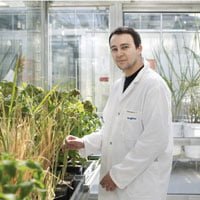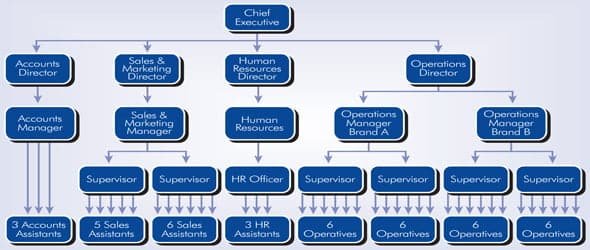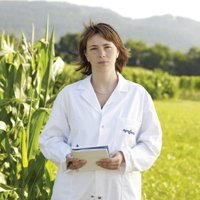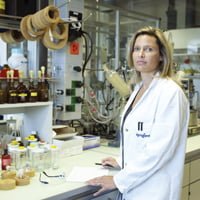
Syngenta is a world-leading plant science business. It is committed to promoting sustainable agriculture through innovative research and technology. Its purpose is ‘bringing plant potential to life. Syngenta currently employs more than 24,000 people in over 90 countries. Its customers range from farmers to governments.
Well-qualified innovative scientists are a core strength of the business. However, the company also needs people in other supporting roles to ensure the products that its scientists develop can reach their chosen markets and customers. A strong focus on recruiting and developing its employees helps Syngenta remain a major player in a highly competitive market. The business prides itself on attracting motivated, talented and involved employees. Once people are recruited, it fully utilises the breadth and depth of their available talent.

Syngenta was formed in 2000 from the merger of the agricultural divisions of Novartis and Zeneca. The company has a wide range of product lines both in crop protection (selective herbicides, non-selective herbicides, fungicides, insecticides) and professional products (including lawn and turf products and seeds (field crops, vegetables) and garden plants.
Throughout the world, farmers and growers are looking to increase the yield from their land. Syngenta’s research teams are devoted to researching and developing products to meet worldwide demand from farmers and agribusinesses for products at competitive prices. Global sales in 2008 were approximately $11.6 billion, with 37% of sales in Europe, Africa and the Middle East and 32% in the NAFTA region.
The case study shows how Syngenta operates though a matrix structure. This involves staff from different departments working together in teams on specific projects and tasks. This approach helps to make the most of all employees’ talents and abilities and enables functions to work together more effectively.
Organisational structure

To fulfil its mission effectively, a business needs to operate within a structure best suited to its purposes. Traditionally large businesses divide the organisation up into functional areas. Syngenta’s functions include research and development, global supply (including manufacturing), human resources (HR), sales and marketing, finance, and Information Systems (IS).
Within any organisation there are likely to be several layers of authority. The number of levels depends upon whether the business has a hierarchical or flat structure. A hierarchical structure has many layers of management, each with a narrow span of control. Instructions feed downwards from one level of management to those below. Feedback comes from the lower levels upwards. The reporting system from the top of the hierarchy to the bottom is known as the chain of command. A hierarchical structure enables tight control. It offers clear opportunities for promotion and may reduce stress levels in both managers and employees. Everybody knows their place in the hierarchy.
However, communication can be a problem in hierarchical organisations. Without effective management, it can take a long time for information to pass up and down the chain of command. Staff may not be fully empowered. Rather than being able to use their initiative, employees may need to seek approval for every action from higher levels of managements. This not only can cause delay but also be bad for employee morale, reducing their motivation to work.
A flat line structure is one where there are few layers of management. Each manager has a wide span of control. This means a manager has responsibility for many people or tasks. Delegation is necessary for tasks to be carried out effectively. This structure gives employees more responsibility for their work. Communication is also faster up and down the layers. This enables problems to be solved more quickly.

The organisation chart shows a typical hierarchical structure in a commercial organisation. There are four functional areas. The accounts department has three layers of hierarchy: a director, a manager and three assistants. The accounts manager therefore has a span of control of three, as he or she directly supervises three assistants.
Syngenta is committed to empowering its staff and a hierarchical structure is not suited to its innovative style. Like many large businesses working in both national and international markets, Syngenta has adopted a matrix structure.
A matrix structure is often referred to as the project team structure. In this approach, team leaders manage specific tasks and projects. Each team will consist of members from different departments, each with their own specialisms and expertise related to the project. It takes employees out of their usual functional areas to work with other employees with different expertise and specialisms. This ensures the project has all the skills it needs to achieve its target. It also means the employees may benefit from each other’s abilities.
Some teams are only formed for a short period of time. They disband when their projects have been completed and the team members are redeployed on other projects. Other teams have a longer or sometimes permanent remit. The matrix structure is not an alternative to functional management but works alongside it. Syngenta’s project teams all support one or more of its business strategies.
Roles and responsibilities

Syngenta has many sections and departments. It is organised into these functional areas:
- Research and development (R&D)
- Global supply (including supply chain management, manufacturing and logistics)
- Sales and marketing
- Global support functions (providing, for example, legal, financial and HR services).
These functional areas effectively run independently. However, by using a matrix management structure, all areas can contribute to the vast range of projects that are running at any one time.
Syngenta uses the skills and competencies of its people to bridge its functional areas. By using people with specific scientific knowledge or experience to lead teams in areas like marketing and production, communication is better within the team. Team members know that the leader understands the issues they face. This can also help to ensure that problems are understood and resolved quickly. These profiles help to demonstrate how Syngenta uses this ‘cross-over’ of talent.
Melanie Wardle is a scientist who now works in Syngenta’s marketing team. Melanie uses her scientific knowledge to help market Syngenta products throughout the UK.
‘My role covers communications planning for all crops and products. This includes advertising and publicity campaigns to meet the marketing objectives for the Syngenta brand. I manage the PR, advertising and design agencies that we work with as well as our internal team, to ensure these activities are implemented on schedule and on budget. I also co-ordinate our presence at major industry events and exhibitions. I enjoy the variety of the work itself and the fact that I get to work with different departments and people, as well as having a close connection to our customers.’

Kathryn Brocklehurst has a PhD in molecular biology. She is now a group leader of one of Syngenta’s functional teams, which focuses on developing products ready for the market.
‘Having previously worked in pure research [at university] I wanted to work on a real product, so I joined Syngenta. There is real job satisfaction from knowing you are helping people the world over to feed themselves by improving food production. I work as a group leader of a project team of 18 scientists, providing materials for other groups to test. I rely on my scientific background to understand and act as an intermediary with the people I manage. As a group leader, my key role is to ensure the right people with the right skills are working on the right projects.’
Jonathan Richards is a scientist working in production. He was recently posted to an international assignment at Syngenta’s manufacturing base in the south of France.
‘I started with Syngenta as a PhD chemist in a research team looking at product formulation. The task was to develop agrochemicals that deliver the active chemical to the site of action in the field in the best possible way. For example, this might be by adding ingredients that stop rain washing a product off the crops (where it is active) to the soil (where it is not). After several years in R&D labs, I now have responsibility for the introduction of new products at one of our manufacturing sites in France. My move to the Mediterranean has been well supported by the company, enabling me to settle in quickly. My scientific problem-solving skills are vital in ensuring production hits its targets, though I now have to think much more about how to get the best out of people rather than products!’
Skills and competencies
Syngenta has a culture of empowering its workers. This enables them to be in control of their work. To fulfil Syngenta’s aims and objectives, employees must also demonstrate specific skills and competencies. Dr Kathryn Brocklehurst explains what this means for her: ‘As a manager and scientist, time management, planning and communication are key skills. I manage a research team and it is vital that our work meets deadlines in order to get products developed for our customers.’
Kathryn’s planning skills are essential as delays could mean that competitors bring out new products first. As a result, Syngenta could lose business. Investment costs are high in the research area. Large research projects can run for 10 years, costing up to £100 million per project. Clear leadership is essential to make this product development work as efficiently as possible.
Leadership skills at this level take time to develop. Kathryn’s career has taken her through many different areas of the business. This experience has helped her develop her understanding of good practice throughout the business. It has allowed her to appreciate what other departments have to offer, enabling her to select the right people for her projects.
For Melanie, the key was to gain experience of the full range of products being developed. This has helped her market the products in the UK. Melanie needed to develop her skills to promote the business’s products. ‘I chose the role at Syngenta because of the wide range of products I’d be working on. My role requires an organised approach and you need to be very diplomatic with good negotiation skills, as I’ll often find myself having to persuade someone to sign off a marketing text at short notice. Syngenta is very keen on developing its employees and helping them grow into new roles. Since starting at Syngenta in 2003, I have worked in three different departments in four different roles. So it’s easy to move your career on if you have the right attitude.’
Jonathan Richards highlights the importance of leadership for the company: ‘Syngenta needs its people to develop leadership skills at every level in the organisation. This is critical to enable the business to progress. Everyone has his or her own unique set of knowledge and skills and team leaders need to use that potential every day. Everyone is encouraged to speak up with new ideas. This open approach not only helps the business to generate new opportunities but also gets everyone’s thoughts on what the best ideas are. This makes Syngenta a fun and rewarding place to work both for developing new breakthroughs and having your work recognised.’
HR strategy
Syngenta is a forward-looking company. It wants its people and leaders to be:
- Passionate about achieving the company’s goals
- Focused on essential areas such as developing new products to deadlines
- Developing new skills and expertise to ensure the highest standards are maintained
- Recognised and celebrated for their achievements
- Creative and innovative in how they work.
Syngenta’s HR team provides training and development opportunities for all staff. For example, it supported Melanie Wardle on a number of training courses, including a CIM Diploma in marketing. It also helped Jonathan and his family move to France.
Kathryn Brocklehurst says: ‘Syngenta has been fantastic in supporting my personal development and in giving me whatever technical training I needed.’
Balancing risk and reward is an important aspect of Syngenta’s management approach. It is committed to research and development to keep ahead of the competition. It is not afraid of mistakes but expects employees and managers to learn from them and use them to motivate people.
The company presents annual awards to employees whose achievements have helped drive the business forwards. These awards are publicised through the company’s magazines and intranet, so everyone inside the company can see how achievement is rewarded. These awards have inspired further innovations and helped employees focus on generating new ideas to help the company perform even better.

Syngenta is a global business operating in a competitive market. It relies heavily on its scientists to research and develop new products. These products enable countries throughout the world to grow sufficient food to feed the ever-increasing world population.
With over 24,000 staff working in 90 countries, Syngenta must organise its resources and use the talents of its people effectively. It uses a matrix management structure, as this is best suited to bringing together people with diverse skills into project teams. This works better than having a tall hierarchical structure with many layers. Team leaders in charge of project teams are trained and supported to help their teams perform to the highest standards.
Syngenta has a commitment to recruiting people with skills and abilities which the business can develop long-term. This benefits employees by providing more challenging role opportunities and it benefits the company by ensuring it has the right talent resources in place for future growth.



